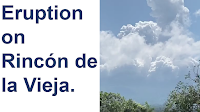The Comisión Nacional de Emergencias in Costa Rica has reported a large eruption on Rincón de la Vieja, an active volcano in Guanacaste Province.in the northwest of the country, on Friday 21 April 2023. The volcano produced an ash column about 7.5 km high, and part of the northern perimeter of the volcano's caldera was breached, causing ash-laden waters from the volcano's lake to escape, and triggering a series of lahars along the courses of the Pénjamo, Azúl and Azufrada rivers. This event is not thought to have caused any injuries or damage to infrastructure, but people are being warned to keep away from the affected waterways.
An ash column over the Rincon de La Vieja volcano, Costa Rica, on 21 April 2023. Observatorio Vulcanológico y Sismológico de Costa Rica-Universidad Nacional.
Rincón de la Vieja is a complex volcano (volcano with multiple eruptive vents rather than a single crater at the top of a cone-shaped mountain) rising to 1916 m above sea-level in Guanacaste Province in the northwest of Costa Rica. It is located within the Rincón de la Vieja National Park, where along with an associated hot spring system it forms an important part of the local economy. Prior to the onset of activity in September 2014 the volcano had been inactive since September 2011, and the last major eruption occurred in 1966. A small geothermal energy project, the Las Pailas Geothermal Power Plant, runs on heat from underground rocks associated with the volcanic complex.
Rincón de la Vieja forms part of the Cordillera de Guanacaste, a range of volcanic mountains running through northern Costa Rica close to the border with Nicaragua and forming part of the Central American Arc. These volcanoes are fueled by the subduction of the Cocos Plate, which underlies part of the east Pacific Ocean, beneath the Caribbean Plate, on which Central America lies, along the Middle American Trench, which lies off the south coast of the country. As the Cocos Plate is subducted it is gradually melted by the heat and pressure of the Earth's interior, with some more volatile minerals rising through the overlying Caribbean Plate as volcanic magma.
See also...








